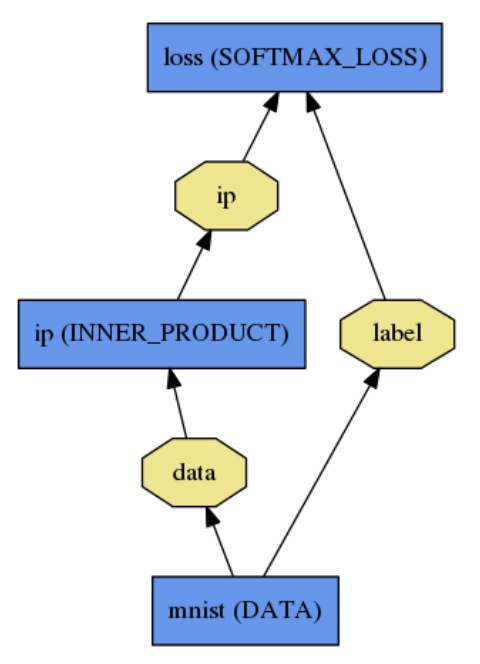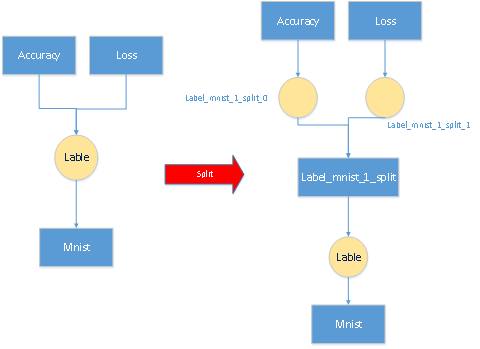caffe 源码学习笔记(3) Net
Net 基本介绍
网络通过组成和自微分共同定义一个函数及其梯度。
网络是一些Layer组成的DAG,也就是有向无环图,在caffe中通常由prototxt定义.
比如
1name: "LogReg"
2layer {
3 name: "mnist"
4 type: "Data"
5 top: "data"
6 top: "label"
7 data_param {
8 source: "input_leveldb"
9 batch_size: 64
10 }
11}
12layer {
13 name: "ip"
14 type: "InnerProduct"
15 bottom: "data"
16 top: "ip"
17 inner_product_param {
18 num_output: 2
19 }
20}
21layer {
22 name: "loss"
23 type: "SoftmaxWithLoss"
24 bottom: "ip"
25 bottom: "label"
26 top: "loss"
27}
定义了

值得强调的是,caffe中网络结构的定义与实现是无关的,这点比pytorch之类的深度学习框架不知高到哪里去了,也是caffe作为部署端的事实标准的重要原因.
Net 实现细节
我们先看下NetParameter的proto
1
2 message NetParameter {
3 optional string name = 1; // consider giving the network a name
4 // DEPRECATED. See InputParameter. The input blobs to the network.
5 repeated string input = 3;
6 // DEPRECATED. See InputParameter. The shape of the input blobs.
7 repeated BlobShape input_shape = 8;
8
9 // 4D input dimensions -- deprecated. Use "input_shape" instead.
10 // If specified, for each input blob there should be four
11 // values specifying the num, channels, height and width of the input blob.
12 // Thus, there should be a total of (4 * #input) numbers.
13 repeated int32 input_dim = 4;
14
15 // Whether the network will force every layer to carry out backward operation.
16 // If set False, then whether to carry out backward is determined
17 // automatically according to the net structure and learning rates.
18 optional bool force_backward = 5 [default = false];
19 // The current "state" of the network, including the phase, level, and stage.
20 // Some layers may be included/excluded depending on this state and the states
21 // specified in the layers' include and exclude fields.
22 optional NetState state = 6;
23
24 // Print debugging information about results while running Net::Forward,
25 // Net::Backward, and Net::Update.
26 optional bool debug_info = 7 [default = false];
27
28 // The layers that make up the net. Each of their configurations, including
29 // connectivity and behavior, is specified as a LayerParameter.
30 repeated LayerParameter layer = 100; // ID 100 so layers are printed last.
31
32 // DEPRECATED: use 'layer' instead.
33 repeated V1LayerParameter layers = 2;
34 }
都很好理解,除了NetState不知道是个什么东西...
继续往下看,看到和NetState有关的两个proto定义如下:
1
2message NetState {
3 optional Phase phase = 1 [default = TEST];
4 optional int32 level = 2 [default = 0];
5 repeated string stage = 3;
6}
7
8message NetStateRule {
9 // Set phase to require the NetState have a particular phase (TRAIN or TEST)
10 // to meet this rule.
11 optional Phase phase = 1;
12
13 // Set the minimum and/or maximum levels in which the layer should be used.
14 // Leave undefined to meet the rule regardless of level.
15 optional int32 min_level = 2;
16 optional int32 max_level = 3;
17
18 // Customizable sets of stages to include or exclude.
19 // The net must have ALL of the specified stages and NONE of the specified
20 // "not_stage"s to meet the rule.
21 // (Use multiple NetStateRules to specify conjunctions of stages.)
22 repeated string stage = 4;
23 repeated string not_stage = 5;
24}
参考 [Discussion] How to specify all-in-one networks #3864 得知,这些参数的主要目的是为了解决部署和训练时,需要多个prototxt的问题.
实际上,部署和训练的protoxt可能大部分都是一样的,只不过是输入,输出以及少部分layer有些差别.如果分为多个文件,会带来的问题就是,如果要修改一些共同的layer,就需要修改两次.
于是可以通过这些参数来控制网络结构,使得部署和训练使用相同的prototxt ,得到一个"all-in-one network"
接下来值得看的是网络的构建部分.
对于一个Net,会顺序构建每个Layer
对于每个Layer,大致分为AppendTop,AppendBottom,AppendParam 三部分.我们重点关注前两部分.
1
2// Helper for Net::Init: add a new bottom blob to the net.
3template <typename Dtype>
4int Net<Dtype>::AppendBottom(const NetParameter& param, const int layer_id,
5 const int bottom_id, set<string>* available_blobs,
6 map<string, int>* blob_name_to_idx) {
7 const LayerParameter& layer_param = param.layer(layer_id);
8 const string& blob_name = layer_param.bottom(bottom_id);
9 if (available_blobs->find(blob_name) == available_blobs->end()) {
10 LOG(FATAL) << "Unknown bottom blob '" << blob_name << "' (layer '"
11 << layer_param.name() << "', bottom index " << bottom_id << ")";
12 }
13 const int blob_id = (*blob_name_to_idx)[blob_name];
14 LOG_IF(INFO, Caffe::root_solver())
15 << layer_names_[layer_id] << " <- " << blob_name;
16 bottom_vecs_[layer_id].push_back(blobs_[blob_id].get());
17 bottom_id_vecs_[layer_id].push_back(blob_id);
18 // ??? 怎么就erase了,一个top后面可以接多个layer的啊
19 available_blobs->erase(blob_name);
20 bool need_backward = blob_need_backward_[blob_id];
21 // Check if the backpropagation on bottom_id should be skipped
22 if (layer_param.propagate_down_size() > 0) {
23 need_backward = layer_param.propagate_down(bottom_id);
24 }
25 bottom_need_backward_[layer_id].push_back(need_backward);
26 return blob_id;
27}
1
2// Helper for Net::Init: add a new top blob to the net.
3template <typename Dtype>
4void Net<Dtype>::AppendTop(const NetParameter& param, const int layer_id,
5 const int top_id, set<string>* available_blobs,
6 map<string, int>* blob_name_to_idx) {
7 shared_ptr<LayerParameter> layer_param(
8 new LayerParameter(param.layer(layer_id)));
9 const string& blob_name = (layer_param->top_size() > top_id) ?
10 layer_param->top(top_id) : "(automatic)";
11 // Check if we are doing in-place computation
12 if (blob_name_to_idx && layer_param->bottom_size() > top_id &&
13 blob_name == layer_param->bottom(top_id)) {
14 // In-place computation
15 LOG_IF(INFO, Caffe::root_solver())
16 << layer_param->name() << " -> " << blob_name << " (in-place)";
17 top_vecs_[layer_id].push_back(blobs_[(*blob_name_to_idx)[blob_name]].get());
18 top_id_vecs_[layer_id].push_back((*blob_name_to_idx)[blob_name]);
19 } else if (blob_name_to_idx &&
20 blob_name_to_idx->find(blob_name) != blob_name_to_idx->end()) {
21 // If we are not doing in-place computation but have duplicated blobs,
22 // raise an error.
23 LOG(FATAL) << "Top blob '" << blob_name
24 << "' produced by multiple sources.";
25 } else {
26 // Normal output.
27 if (Caffe::root_solver()) {
28 LOG(INFO) << layer_param->name() << " -> " << blob_name;
29 }
30 shared_ptr<Blob<Dtype> > blob_pointer(new Blob<Dtype>());
31 const int blob_id = blobs_.size();
32 // 先取blob_id,再push_back 说明blob_id是从0开始递增的整数.
33 // blob_id都是在appendTop时定义的
34 blobs_.push_back(blob_pointer);
35 blob_names_.push_back(blob_name);
36 blob_need_backward_.push_back(false);
37 if (blob_name_to_idx) { (*blob_name_to_idx)[blob_name] = blob_id; }
38 top_id_vecs_[layer_id].push_back(blob_id);
39 top_vecs_[layer_id].push_back(blob_pointer.get());
40 }
41 // 维护一个出现过的top blob集合,目的是判断后面所接layer的bottom blob名称的合法性
42 // 这里要判断 available_blobs 是否为NULL是因为,可能构造匿名的top blob,此时available_blobs
43 // 和 blob_name_to_idx 都会传NULL 值
44 if (available_blobs) { available_blobs->insert(blob_name); }
45}
代码比较好懂,解析部分见注释... 唯一值得注意的地方是available_blobs这部分的维护.在AppendBottom中
1
2 // ??? 怎么就erase了,一个top后面可以接多个layer的啊
3 available_blobs->erase(blob_name);
每次处理完一个bottom就从available_blobs 去掉.
然而,一个top blob明明是可以输入给多个layer的... ????? 不明白
查阅资料看到 What does InsertSplit() / SplitLayer do? #767
原来
// Create split layer for any input blobs used by other layers as bottom // blobs more than once.
对于被多个layer用作bottom的top blob,做了分身...

可以参考Net的网络层的构建(源码分析)
Posts in this Series
- caffe 源码阅读笔记
- [施工中]caffe 源码学习笔记(11) softmax
- caffe 源码学习笔记(11) argmax layer
- caffe 源码学习笔记(10) eltwise layer
- caffe 源码学习笔记(9) reduce layer
- caffe 源码学习笔记(8) loss function
- caffe 源码学习笔记(7) slice layer
- caffe 源码学习笔记(6) reshape layer
- caffe 源码学习笔记(5) 卷积
- caffe 源码学习笔记(4) 激活函数
- caffe 源码学习笔记(3) Net
- caffe 源码学习笔记(2) Layer
- caffe 源码学习笔记(1) Blob